Consistency and regimentation—are the two words that salespeople swear by. Even though each sales deal is different, standardizing the process leads to faster conversions.
But before your sales team gets to conversions, there are many milestones that they need to cross in the sales process. It’s like a video game where you can’t reach the next level before you clear the one before it.
But how do you decide these stages, and what’s the guarantee that you’ll make it to the next level?
That’s what a sales cycle is for.
What is a Sales Cycle?
A sales cycle is an order of stages a prospect goes through before converting into a customer. It is a step-by-step execution of your organization’s sales strategy. The 7 most important stages in a sales life cycle are:
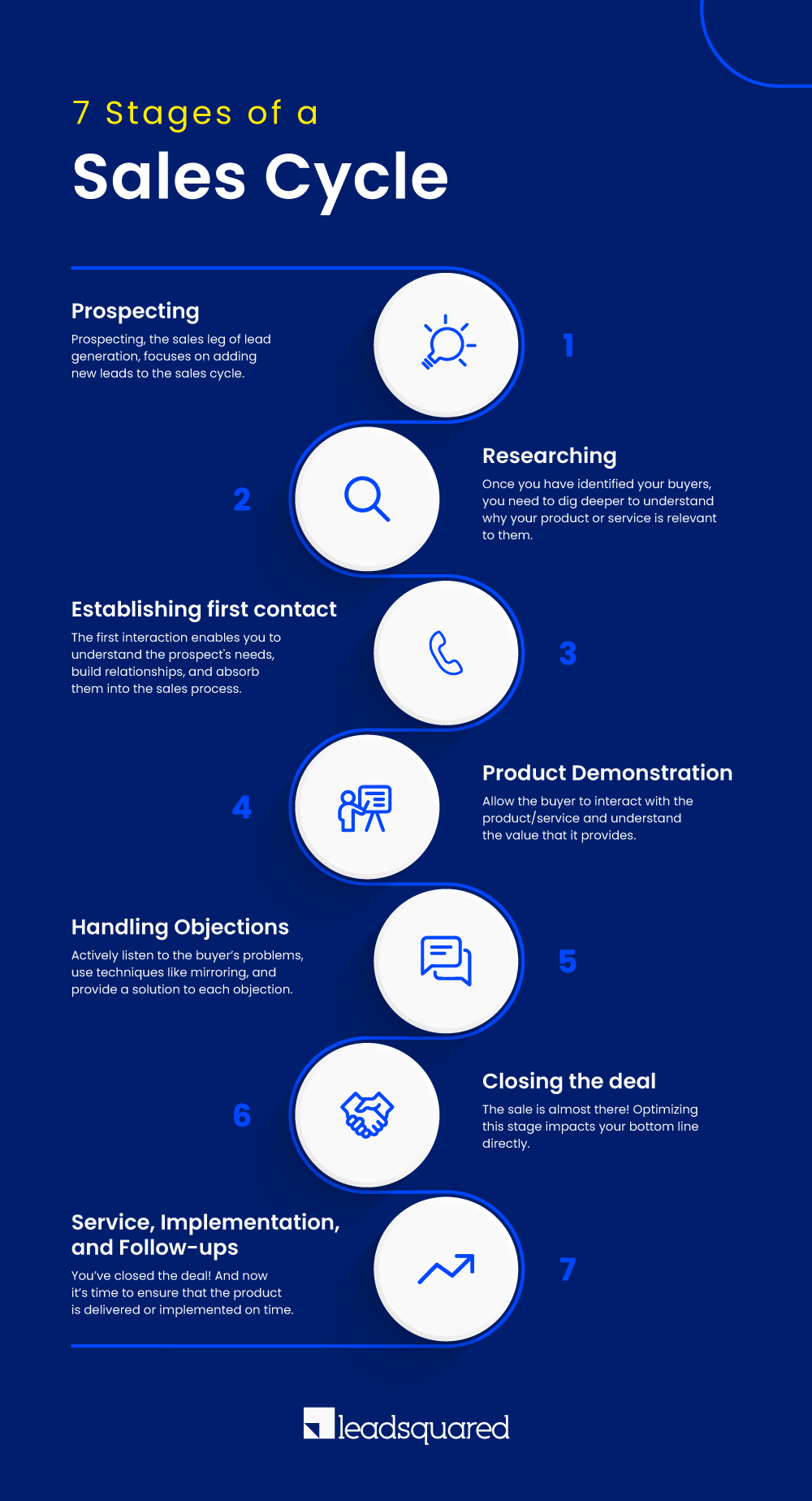
Most businesses, knowingly or unknowingly, do have a sales cycle. However, reducing your sales cycle length depends entirely on how you optimize your sales funnel stages.
Before we go into the depth of each sales process, let’s understand how sales cycles differ for B2C and B2B organizations.
Sales Cycle for B2B and B2C Organizations
The sales cycle differs for B2B and B2C organizations because it is highly dependent on buying behaviour related to the product or service. Three factors set these cycles apart:
- Length of the sales cycle
- Level of decision-makers
- Lead volume.
B2B Sales Cycle
The B2B Sales Cycle is a bit more complicated than the B2C sales cycle. This is because the scope of the decision to be made—whether to buy the product or not—is at a much higher magnitude. While selling a B2B service, there are multiple decision makers whom the salesperson must interact and possibly negotiate with. These interactions elongate the sales cycle, which falls in the 4 to 12-week range.
But the sales team can manage to handle these leads because the lead volume or lead generation efforts are not as high as those in the B2C sales cycle. The salespeople need to put in a lot more effort in the demonstration, negotiation, and closing stages of the B2B sales cycle.
B2C Sales Cycle
B2C sales cycles, even if less complicated, are known to be fast-paced and stressful for salespeople. Here, the decision maker is the customer, and the sales cycle length is much shorter; but the organizations encounter enormous lead volumes that their teams can’t handle. The sales cycle stages that B2Cs must focus on are research, qualification, and the first call.
Since the length of the B2C sales cycle is usually under one week, the first interaction can make or break the deal. Hence B2Cs require lead management software that can automate lead distribution and prioritization to reduce turnaround time. Reaching out to your customers faster to understand their challenges ensures a shorter sales cycle.
Creating a well-defined sales process for your sales team helps businesses close more deals and be 33% more likely to be high performers in their industry.
You might be wondering why organizations find it so hard to just define a few processes for their sales team. It’s because each process is an integral function of sales and has challenges. To bring to you practical insights, we spoke to sales experts from different domains.
- Vineet Kumar Tiwari, Assistant Vice President-Sales (India), LeadSquared
- Raghvendra Tripathi, Senior Vice President-Sales, LeadSquared
- Akhil Pandey, Team Manager – Revenue Assurance, LeadSquared
- Pearl Singporewalla, Director-Training, UpGrad
Their tips will help you optimize each sales cycle stage to boost sales performance.
7 Stages of a Sales Cycle
1. Prospecting
Before beginning any sales process, salespeople need to know who to sell to. Prospecting, the sales leg of lead generation, focuses on adding new leads to the sales cycle. Almost 50% of salespeople find prospecting the most challenging aspect of the sales process because it requires time and effort.
But prospecting is essential to ensure that sales pipelines don’t run dry. The first step in your prospecting journey is understanding your customers. You can utilize or build your ideal customer profile using the following recommendations.
To begin, you need to create an Ideal Customer Profile (ICP) and a buyer persona. These act as filters that help salespeople add new leads to their pipeline.
Building an Ideal Customer Profile (ICP)
An customer profile can be built by looking into the businesses your sales team focuses on. The ideal customer for any business is a company with a high ROI and customer lifetime value. A few attributes that you can use to build a customer profile are type of industry, number of employees, budget criteria and, revenue.
Building a Buyer Persona
Once you have your ICP in place, you have a database of companies that you can contact. But you also need to know who your buyer will be. For B2C companies, the buyer persona is the only filter salespeople use while prospecting. A few attributes to consider while building a buyer persona are job title, professional background, pain points, and experience with technology.
The buyer persona depends on the type of industry, so these parameters may not be relevant to all businesses. For example, an Edtech requires educational background information but not a job title since that’s not a relevant parameter for students.
Once salespeople know who to reach out to, they need a database of lead information. They can find the lead’s contact details from platforms like LinkedIn, ZoomInfo, or Lusha.
Prospecting isn’t a one-time task, though. Salespeople need to put some time aside to ensure that they have enough leads to reach out to. They can also look into their personal and professional networks to build meaningful relationships with prospects.
“Relationship building is an important aspect of prospecting. Salespeople need to look beyond the quarter and invest in creating opportunities for the future. I advise my sales team to spend more than 50% of their time in the field and initiate conversations with the movers and shakers in the market.”
Raghvendra Tripathi, Senior Vice President-Sales, LeadSquared
2. Researching
Picking up the phone without knowing anything about the lead can be fatal. Once you have prospected and chosen the buyers, you need to dig deeper to understand why your product or service is relevant to them.
Many salespeople skip the research phase. But because of this, they lose the chance to establish a mutual point of interest. Just taking a glance at the prospect’s LinkedIn profile helps you understand their interests, organization details, and background. While researching the company, look up news related to growth and funding, investigate their competitors and product offering, and much more.
For a B2C sale, you need to understand why the buyer would need your product—what they do, their educational background, economic conditions, likes, and dislikes.
Social Media and marketing campaigns have become hyper-personalized as well. If the buyer has been in your database for a while, use lead engagement techniques to nurture them. Using a marketing automation platform, salespeople can gauge the lead’s interest based on the campaigns they have interacted with. This allows them pitch the product/service accordingly.
3. First Contact and Qualifying
The first impression is the last impression, especially in sales, because if the first call goes wrong, getting a second meeting is almost impossible. The first interaction should be over a platform that they’re comfortable with, and it shouldn’t corner or force them into deciding. Buyers are open to connecting with salespeople via LinkedIn (21%), SMS (21%), social media (18%), and in-person at industry events (34%).
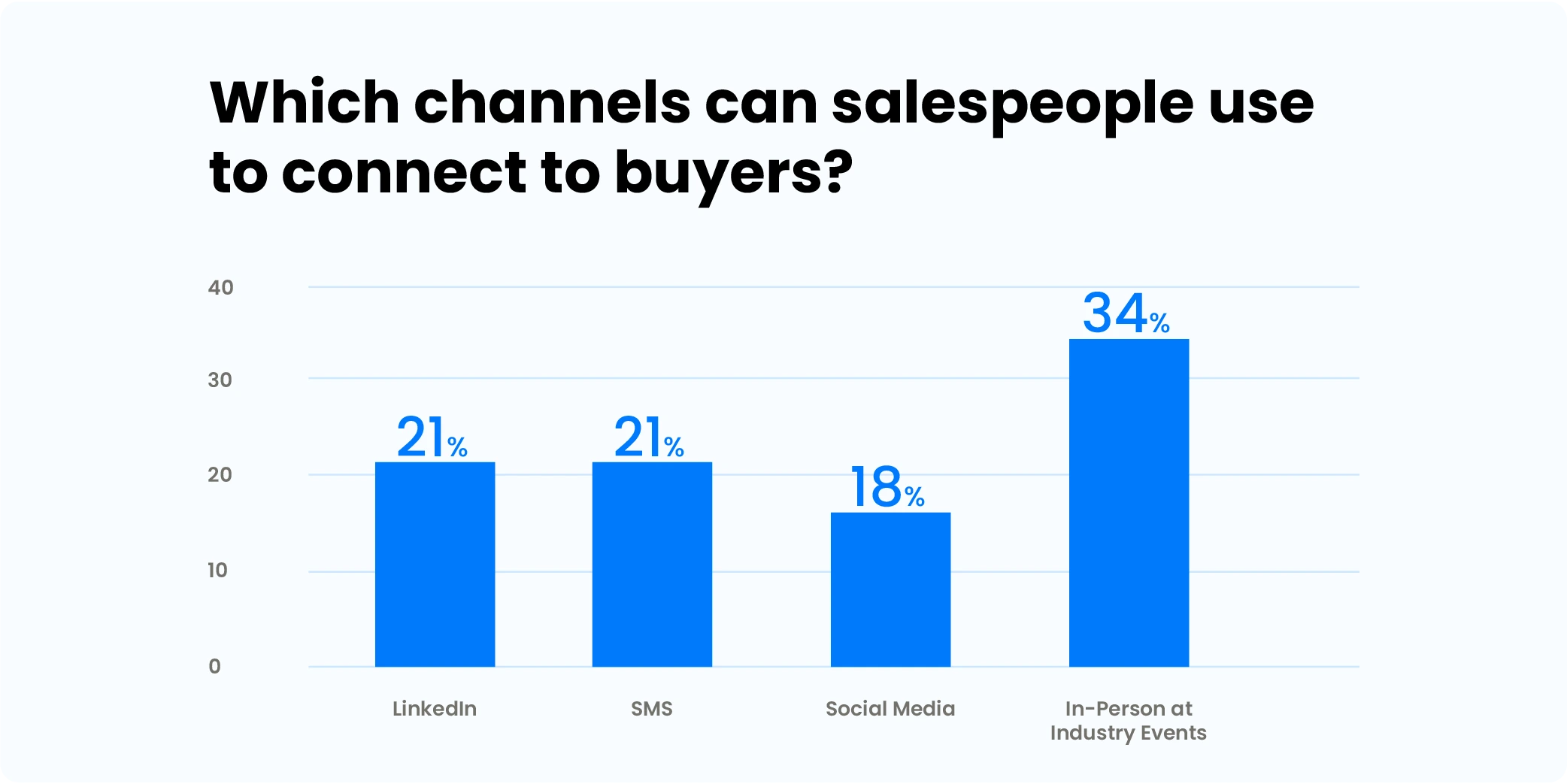
The first interaction or the discovery call enables you to build relationships with prospects, understand their needs and absorb them into your sales process. However, too often, sales reps go about it the wrong way. They are either too pushy about giving a demo or just keep pitching their product.
“Use this opportunity to figure out if the buyer is a good fit for your product. A few qualifying questions will help you pick the top 10% of leads with a 90% chance of closure.”
Raghvendra Tripathi, Senior Vice President-Sales, LeadSquared
The qualifying questions at this stage fit the BANT framework:
- Budget: What budget has the person/organization set aside to solve their challenges?
- Authority: Is this lead a decision maker at the organization? To what extent can he influence the decision being made?
- Need: How much impact your solution have on their business? What do they hope to change with a new product/service? What goals do they wish to achieve?
- Timeline: How soon do they want to implement a change?
For B2C businesses, when the lead volume is in thousands, the qualifying stage can be automated to filter out the high-priority leads using lead scoring. However, the battle is yet to begin. According to research by LeadSquared, 54% of salespeople say that you need to create 5-10 touchpoints after a discovery call before you complete a sale.
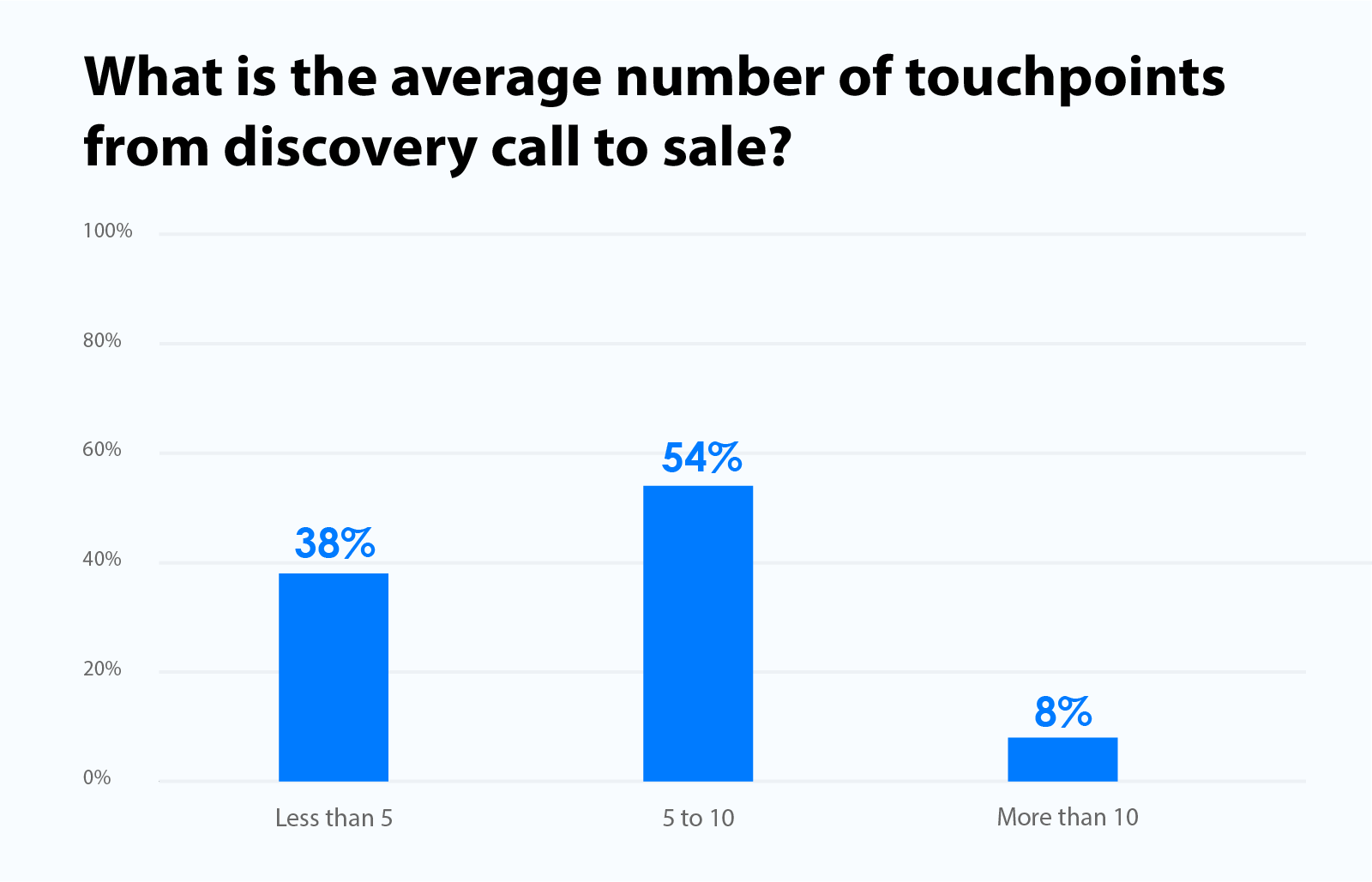
Through the lead qualification process, you can figure out whether this opportunity would move ahead in the funnel or not. And if it looks positive, the next step will be product demo.
4. Product Demonstration
At this stage, you know what your buyer is looking for, and their intent towards the purchase. Seasoned salespeople can attribute a closing percentage right after the demonstration. Product demonstration is a commonly used term in the SaaS business. But this stage applies to all industries differently. For example, giving a free first class for EdTechs, a property showing in real estate, or accompanying the buyer for a test drive for a car dealership.
The intention is to let the buyer interact with the product/service and understand the value that it’ll provide. While the way to give a demo is standard, show them the features and capabilities of your product, this approach gets boring fast.
Here are a couple of dos and don’ts for an effective product demo:
Dos:
1. Use storytelling: Nobody wants to listen to a list of features and customers on a call. You need to keep them hooked and show what your product can do instead of telling them about it. Storytelling helps you tackle the buyer’s pain point from an emotional angle.
“People don’t really buy your product, solution, or idea—they buy the stories that are attached to it.”
Michael Margolis, Author of the book Believe Me: A Storytelling Manifesto for Change-Makers and Innovators
2. Keep it short: More than 75% of businesses keep their sales demo between 30 minutes to 1 hour. Good demonstrations are under an hour and focus on the most important business offerings. Complicating the demo can confuse the buyer and make the product seem difficult to implement.
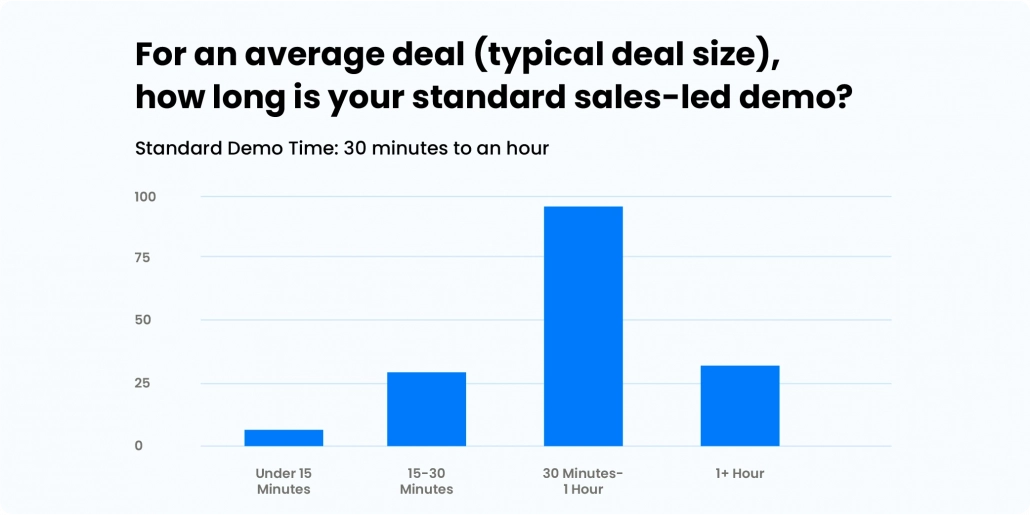
3. Focus on the value: What are the real challenges you help a buyer solve? You just need to translate them into digestible and easy-to-understand segments in the demonstration. The buyers want to know how much time they’ll save and what kind of results they’ll achieve instead of the specifications of your product.
Don’ts:
1. Lack of customization: Use the ICP to curate the product experience. A generic format doesn’t give you the same results. The customization can be based on the buyer’s personality, business challenges, and the kind of industry they belong to.
2. Sell instead of consult: Nobody likes being sold to, no matter how well you do. Pivot your approach from sales to problem-solving, and that’s where the magic happens. 88% of people are only willing to buy from an advisor who they trust rather than a salesperson.
3. Use the phrase “I’m not sure about that”: It takes a lot of effort to get your buyer on a call to listen to your pitch. A salesperson must have all the product and implementation knowledge so that you can answer all the buyer’s questions during the demo. These build trust and can speed up the process.
5. Handling Objections
Hear me out, objections are not your enemy! It’s so much better than hearing a “no” because it means that the buyer is considering your product. You just need to tackle these objections before onboarding the buyer.
The objections can be in terms of pricing, feature usage, and the scope of results that they can achieve with your product. Salespeople can get through this stage by actively listening to the buyer’s problems, using techniques like mirroring, and giving a solution to each objection raised.
Also read: Guide To Overcoming 21 Most Common Sales Objections
Using social proof and sharing resources like case studies, legal documents for data-compliance-related objections helps salespeople reach the closing stage faster.
The negotiation should be value-driven, and the buyer should know what ROI they can expect from your product. While proposing an offer, you need to keep a financial buffer than the buyer can meet you on. These two tips can help you handle most of the objections that come your way.
Vineet Kumar Tiwari, Assistant Vice President-Sales (India), LeadSquared
6. Closing the deal
Closing a sale requires years of training and practice. The average sales close rate is between 15-30%, but businesses can increase their close rates with the right practices. Since this stage is almost towards the end, optimizing it will impact your bottom line directly.
A few closing techniques that work well for most salespeople are:
1. The puppy close: To speed up closures, you can offer your buyers a trial of your product. This gives them a chance to explore the product and decide.
2. Consultative close: Check with your buyers if they have any more questions or want to discuss a certain concern. This approach works well if the buyer is apprehensive about change or finds the product complex.
3. Takeaway close: If the prospect doesn’t budge on the pricing, you can remove a few features or offer them a lower-value plan which they can test out for a few weeks before upgrading it.
4. Now or never close: The discount, or a deal, is offered but for a limited period. For example, the buyer will receive $250 off if they close the sale before midnight.
To know more about closing techniques, check out this awesome resource: 15 Smart Sales Closing Techniques [Scripts and Examples]
7. Service, Implementation, and Follow-ups
You’ve closed the deal! And now it’s time for you to deliver everything you offered. Since the buyer’s point of contact is the salesperson, they must ensure that the product is delivered or implemented as soon as possible.
It’s a healthy process to touch base with the customers weekly or monthly. Utilize this chance to understand their product usage and any challenges that they may face. These calls help businesses with a recurrent purchase model, because you get an opportunity to justify their purchase and encourage them to revise their subscription or upgrade it for the next quarter.
Akhil Pandey, Team Manager – Revenue Assurance, LeadSquared
You can also keep the customers in the loop by adding them to your marketing initiatives to share product updates and invites to customer events. 90% of Americans believe customer service is a make-or-break factor when purchasing a new service. So, every business must create multiple channels for service where the customer can look up for help or reach out to someone from your team. Following up on customers and providing top-notch customer service sets your brand apart and helps you increase customer lifetime value.
The end of your sales cycle is also the perfect time to ask your buyer for referrals. But you need to give them some time to try out the product. The 3-12 month range is an appropriate time to reach out to them for a referral, but most salespeople forget their sales deals by then. Using a CRM that schedules emails in advance or sets automated referral reminders can help you increase your sales revenue over time.
The sales cycle looks like a straightforward step-by-step process when you break it down into its different stages. But that’s not the case because salespeople handle multiple sales deals parallelly to achieve their sales quota every quarter. There might also be situations where multiple sales members are a part of the same sales cycle—when someone leaves the team or if there are different teams like SDRs, presales, and customer relationship managers involved.
The solution to both these challenges is Sales Cycle Management.
What is Sales Cycle Management?
Sales cycle management is how businesses track and optimize their sales cycles. An overall in-depth view of each stage in your sales cycle helps leaders identify the potential leaks and obstacles slowing down sales performance.
Sales cycle management aims to improve sales efficiency and enable reps to sell better with the help of sales automation tools like CRM. LeadSquared is a sales automation platform that gives a complete view of the cycle with its Smart Views, and the salespeople can store notes and objections on the platform, turning sales into a collaborative effort for the team.
Vineet Kumar Tiwari, Assistant Vice President- Sales, LeadSquared, with over 13 years of experience in sales, shares his insights on how you can improve sales cycle management using automation. Watch this video:
Tips to improve sales cycle management
A few ways to optimize sales cycle management for most businesses are:
1. Track sales metrics
Sales metrics are an accurate representation of sales performance. Tracking them helps you understand how fast the pipeline is moving in the sales cycle and what you can do to improve it. Few impactful metrics to track the sales cycle are:
- Pipeline Velocity
- Length of the sales cycle
- Churn rate
- Opportunity-to-Win Ratio
- Target achievement analytics
Read: 32 Sales KPIs Every Manager Should Measure to know more about sales performance metrics.
2. Standardize training
Formalizing the sales cycle also means salespeople must shift from their usual methods to a new sales cycle process. To achieve these results, you must standardize your sales process using a sales management tool that is easy to use. Training also involves getting on the ground with your sales reps to work on their sales negotiation and closing techniques.
“When designing your training programs, it is important to identify the kind of people you’ve onboarded based on their past experiences. You should customize your training programmes as far as possible to benefit people from various backgrounds.”
Pearl Singporewalla, Director-Training, UpGrad
3. Align sales and marketing
Sales and marketing teams must work together to identify customers’ questions at various stages of the buyer’s journey. They must match those questions and concerns to specific customer profiles. Marketing teams can understand customer queries and develop content to answer those questions. Your sales team can also provide content to their customers to keep them interested in the product.
4. Shorten sales cycles with automation
The average sales cycle length is 4-6 months for new customers. To increase sales revenue, businesses need to decrease the sales cycle length. LeadSquared CRM helps you automate the prospecting (with marketing automation) and nurturing stage (with scheduled emails and reminders) to decrease the length of sales cycles. Real-time access to sales analytics data also helps the salesperson plan multiple sales cycles parallelly.
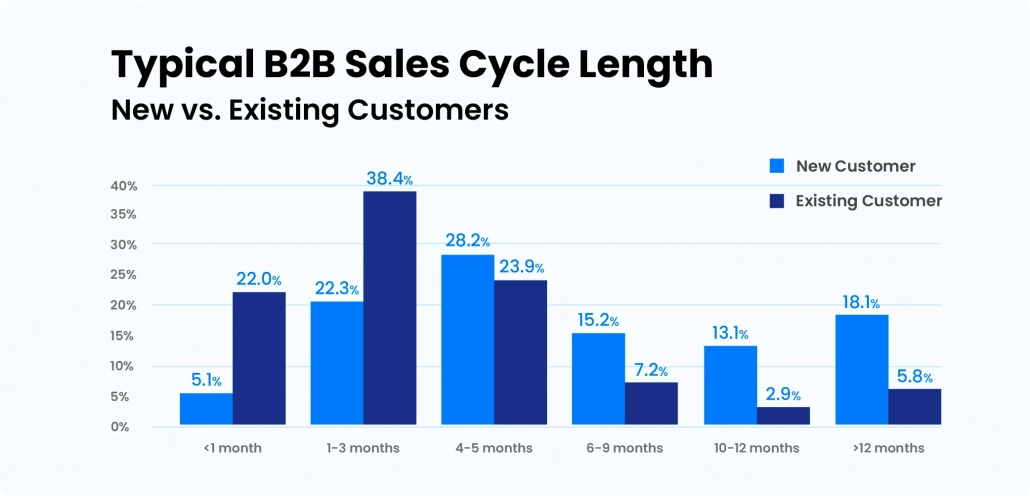
5. Improvise
Even though the sales cycle stages apply to most businesses, you can tweak them according to your team’s requirements. For example, adding a follow-up stage and modifying demos for different decision makers at an enterprise. Before improvising, ensure that your tracking and reporting tools provide you with relevant data to make decisions.
All these practices require a sophisticated sales cycle management tool to track, evaluate, and analyze sales cycles. Let’s figure out how you can choose the right one for your business.
Sales Cycle Management Tools
Before choosing a sales management tool, define your sales process and goals. The sales management tool that you choose should help you improve:
1. Prospecting and Qualification
While choosing the software, consider all lead generation and prospecting mediums. The sales management tool must integrate leads from all sources into a single platform. Automated lead qualification using filters and lead scoring saves your salespeople a couple of hours of manual work.
2. Customer Interaction and Nurturing
85% of the time, prospects have to wait three days to receive a demo after requesting one. But automation helps you decrease this turnaround time or at least make it more engaging with relevant content. Salespeople should have a dashboard that provides them with all the demo-related information and automated reminders to ensure that the demo is done on time. Automated communication with the buyer keeps your brand recall value high, making buyers feel valued in the sales process.
3. Analytics and Reporting
Sales performance, progress, and pipeline information are imperative to sales cycle management. As your team size increases, you can’t rely on collecting and reporting data manually. The right sales management tool gives you an in-depth view of your sales cycle to spot obstacles that may be slowing it down.
We have created a sales management tool checklist for your team that’ll help you decide on a tool that works for your business.
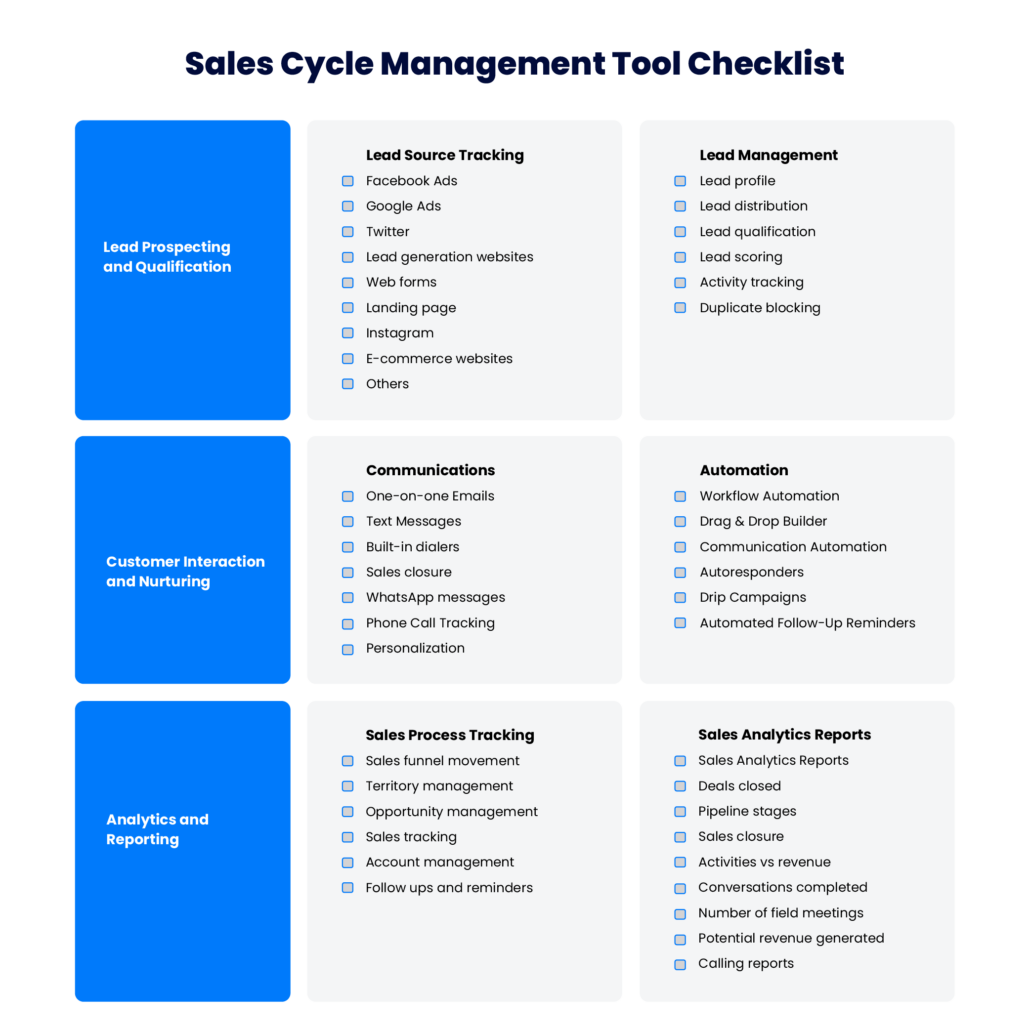
You can also download this checklist to share it with your team or refer to later: Sales Cycle Management Tool Checklist.
A CRM is the perfect sales cycle management software. Along with sales cycle management, it also sorts out sales strategy, sales operations, and sales forecasting for your business. So, if you’re ready to optimize your sales cycle, you should give LeadSquared CRM a shot!
FAQs
A sales cycle is an order of stages a prospect goes through before converting into a customer. It is a step-by-step execution of your organization’s sales strategy. The 7 most important stages in a sales life cycle are:
1. Prospecting
2. Research
3. First Contact and Qualification
4. Product Demonstration
5. Handling Objections
6. Closing the Deal
7. Service, Implementation, and Follow-ups
Salespeople can get through the objection stage by actively listening to the buyer’s problems, using techniques like mirroring, and giving a solution to each objection raised. Managers can also provide their team with scripts to handle sales objections that prepare them for every scenario.
Tracking, visualizing, and reporting all sales processes help you find gaps in your sales process that need to be worked on. These challenges can be tackled with training or by revising your sales strategy. You can also decrease the length of your sales cycle by automating a few stages, such as prospecting, lead qualification, and nurturing using a CRM.





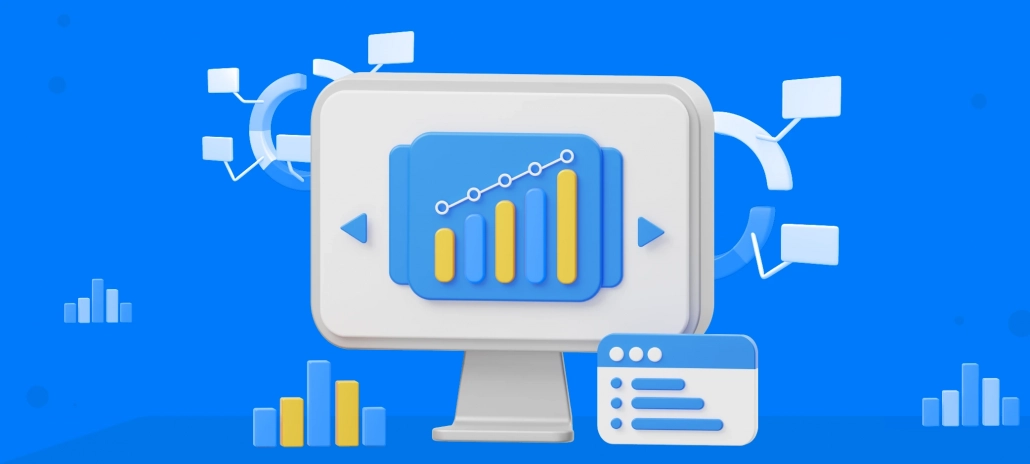


![[Webinar] Maximizing ROI with WhatsApp CRM](https://www.leadsquared.com/wp-content/uploads/2024/07/Maximizing-ROI-with-WhatsApp-CRM-webinar-popup.gif)
